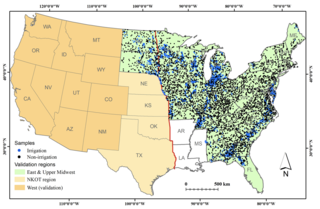Landsat-based Irrigation Dataset (LANID): 30 m resolution maps of irrigation distribution, frequency, and change for the US, 1997–2017
Y. Xie et al. "Landsat-based Irrigation Dataset (LANID): 30-m resolution maps of irrigation distribution, frequency, and change for the U.S., 1997–2017" Earth System Science Data 13 (2021) [DOI:10.5194/essd-13-5689-2021]
Data on irrigation patterns and trends at field-level detail across broad extents are vital for assessing and managing limited water resources. Until recently, there has been a scarcity of comprehensive, consistent, and frequent irrigation maps for the US. Here we present the new Landsat-based Irrigation Dataset (LANID), which is comprised of 30 m resolution annual irrigation maps covering the conterminous US (CONUS) for the period of 1997–2017. The main dataset identifies the annual extent of irrigated croplands, pastureland, and hay for each year in the study period. Derivative maps include layers on maximum irrigated extent, irrigation frequency and trends, and identification of formerly irrigated areas and intermittently irrigated lands. Temporal analysis reveals that 38.5×106 ha of croplands and pasture–hay has been irrigated, among which the yearly active area ranged from ∼22.6 to 24.7×106 ha. The LANID products provide several improvements over other irrigation data including field-level details on irrigation change and frequency, an annual time step, and a collection of ∼10 000 visually interpreted ground reference locations for the eastern US where such data have been lacking. Our maps demonstrated overall accuracy above 90 % across all years and regions, including in the more humid and challenging-to-map eastern US, marking a significant advancement over other products, whose accuracies ranged from 50 % to 80 %. In terms of change detection, our maps yield per-pixel transition accuracy of 81 % and show good agreement with US Department of Agriculture reports at both county and state levels. The described annual maps, derivative layers, and ground reference data provide users with unique opportunities to study local to nationwide trends, driving forces, and consequences of irrigation and encourage the further development and assessment of new approaches for improved mapping of irrigation, especially in challenging areas like the eastern US.
The annual LANID maps, derivative products, and ground reference data are available on Zenodo.
